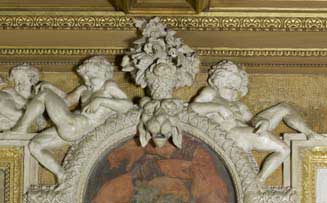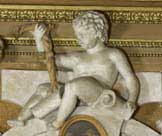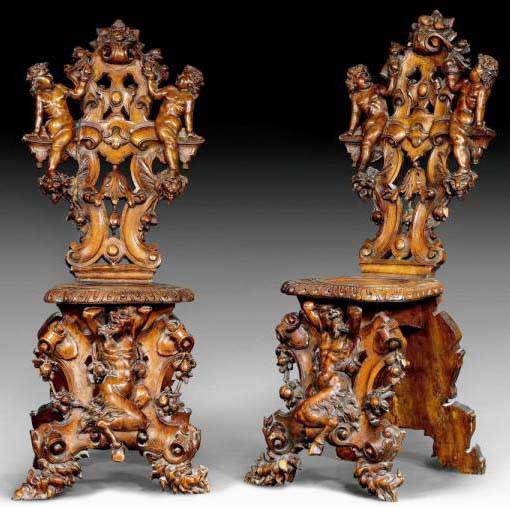
These chairs are some of the most beautiful we have ever acquired. They are rich in decorative elements from the Renaissance, as if their creator sought in the late 19th century to distill the art of 16th century France into a more portable form for private enjoyment.
As we will discuss below, these chairs are heavily dependent on figures created out of plaster (also called stuccoes) by Rosso Fiorentino (1494-1540) to surround his frescoes in the Galerie François I at the Chateau of Fontainebleau. This room was part of a colossal project to transform a small hunting lodge into one of the most regal residences of King François I (reigned 1515-1547). For more about this, including the king's manifestation of his affection for Rosso's work, see the article describing our most recent visit to the Château de Fontainebleau.
The Galerie is a long corridor with paintings (frescoes), surrounded by elaborate designs in plaster (called stucs in French). The frescoes and their frames are above the magnificent walnut paneling that is at eye level. Conceived and executed by Rosso Fiorentino, aided by an army of assistants, at least three of the frescoes are believed to have been painted by the master. The frescoes tell various tales from mythology and ancient history, unified by the theme of François I as monarch and military leader of France.
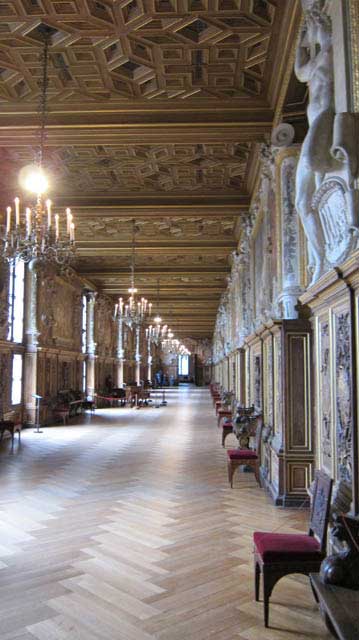
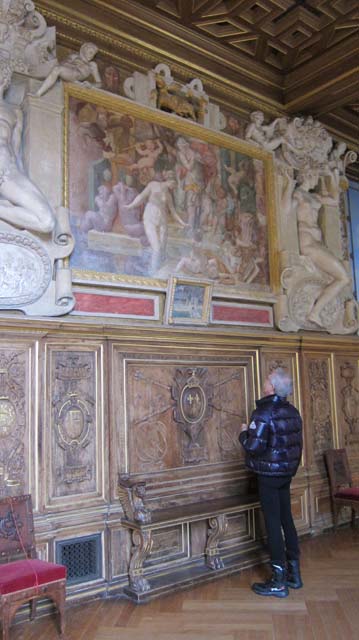
The sculptures made from plaster are Rosso's masterpieces of design and innovation. It is impossible to underestimate their impact for generations on countless artisans, including furniture designers, by means of books of prints and engravings of Rosso's designs made by contemporary and later artists. These circulated around Europe for centuries with many now preserved in museums and allowing us to appreciate just how vast Rosso's influence was.
Rosso was not necessarily the originator of all of the images among the array that he used in his design for the Galerie but his synthesis of them was revolutionary. Speculation is that he absorbed and re-interpreted what he saw while working in Rome and what he learned from other artists he encountered there, such as Raphael and Michelangelo, before heading to France. His fertile imagination and genius for design found their ideal outlet in planning and executing the monumental project that the Galerie became. Whether through inadvertence or intention, Rosso succeeded in creating a new style while launching a passion for his stylistic elements which remained paramount in France for centuries.
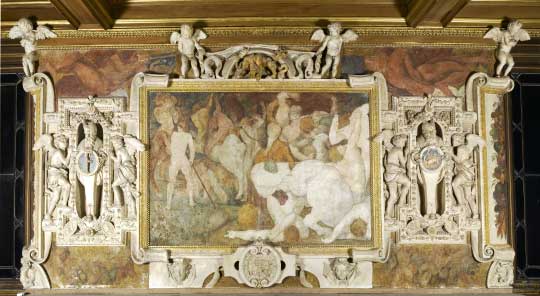
Eugene Carroll, our friend and Meril Markley's professor of Art History at Vassar College, best summed all of this up on his website devoted to Rosso Fiorentino (Chapter VIII page 51), "The abundance, even super-abundance, of diverse motifs and combinations of motifs in the gallery, enhanced in effect by the largeness of them — and hence unlike Roman grotesque decoration — and by their execution in stucco and in painting, provides not only an apparently endless sequence of enjoyable experiences but also a degree of bewilderment."
It is with just such bewilderment, and a sense of awe, that we examine our sgabelli and their links to Rosso's masterpieces at Fontainebleau. We will never know whether the creator of our chairs took his inspiration directly from visits to the Galerie or from books of design incorporating elements from it. Either way, his affection for Rosso's designs is evident when tracing elements of our chairs back to their sources at Fontainebleau.
Starting with an overview, the action taking place in the frames around the frescoes in the Galerie François I gives the viewer a sense that the room is not solely about pomp and adulation for the monarch. Rather, it is about pleasure, beauty, and history in which the monarch plays a role. Plaster figures are engaging with one another, exhibiting playfulness and mischief, while fulfilling their wide-ranging roles. For example, youths strike an athletic pose propped against a frame. Putti act out tugs-of-war with drapery or garlands and puff out their cheeks while blowing into elongated horns. They stand nonchalantly, with arms crossed, while looking downward (toward us) from atop scrollwork or peeking around the corner of a niche. They hold up frames of artwork, play amidst the feet of much larger figures, and support a salamander (the emblem of François I) while dangling a leg over the frame of a fresco as if to spring into our, the viewer's, space. Older youths relax and recline languorously, draping themselves atop the frames of frescoes while looking in the direction of the next scene, as if to direct our progress along the corridor. To enjoy the stuccoes in more detail, we suggest this collection of images from the official website of French National Museums.
It is as if the plaster figures that Rosso created to surround his frescoes have sprung onto our chairs to become a somewhat portable version of his timeless designs. The main characters are two significant types of figures used by Rosso in the Galerie but having their roots in ancient mythology — the putto and the satyr.
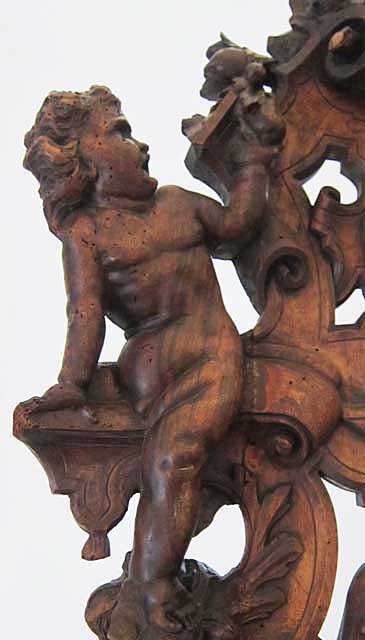
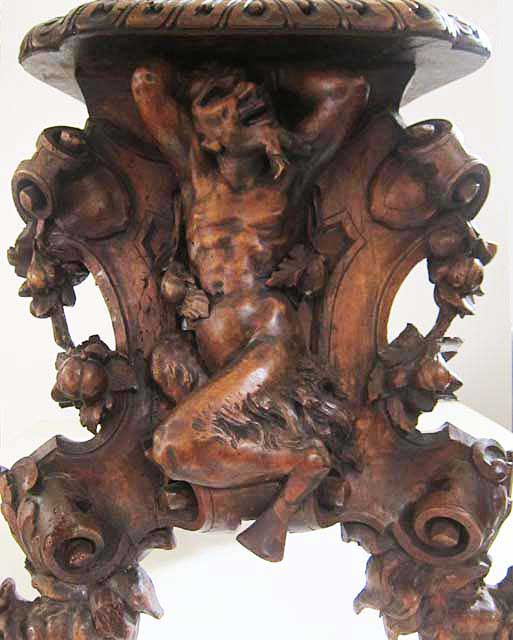
The putto as an image in art dates back well before the Renaissance to ancient cultures on the Italian peninsula such as the Etruscans and the Romans. A putto is always male and always a child, though that may vary from chubby infant to pre-teen youth. Sometimes putti have wings but they are not obligatory. In ancient times, they were depicted with Cupid and Venus (and also called erotes) as well as with Bacchus and Dionysius where they symbolized the abundance of fruit and the enjoyment of grapes in the form of wine. The Etruscans depicted them in groups divided by garlands of flowers or fruits, a motif soon appropriated by the Romans. It was not until the Baroque period that they were seen more commonly in their winged form as angels in religious paintings.
In ancient depictions of putti they were engaged in all sorts of escapades, including driving chariots and cavorting with garlands, as shown on Roman sarcophagi. Clearly, their spirited images and mischievous tendencies were highly valued millennia ago.
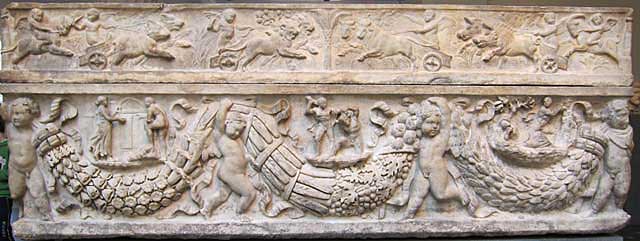
When artists in early 16th century Rome rediscovered ancient buildings (dubbed grottoes) under the city's more modern foundations, they too did not hesitate to adopt the rich decorative vocabulary of another culture as their own. Whether Raphael and his elaboration of grotesque decorative panels or Rosso and his putti, the Italian artists of the Renaissance used them widely in paintings, sculpture, and architecture. Perhaps one of the most recognizable of Renaissance putti is the one called musicante, a small painting by Rosso in the collection of the Uffizi Gallery in his hometown.
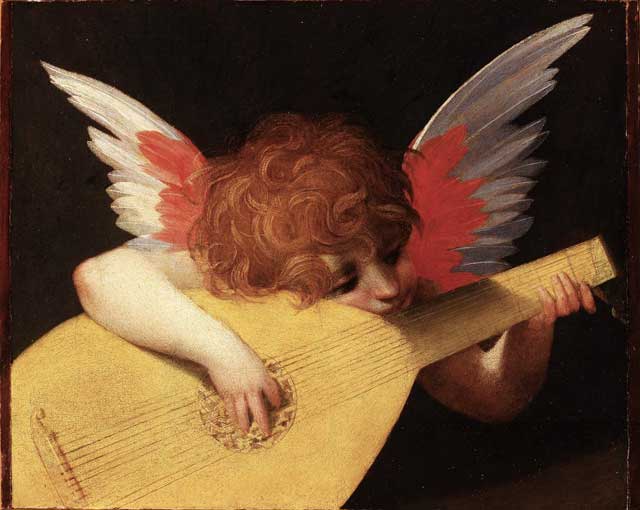
Like their ancient forbears, Rosso's figures are involved in all manner of activities evoking the freewheeling antics of the putti of ancient Rome, as the following images from the Galerie illustrate. These must have given great pleasure to the King as well as to his visitors who were required to traverse the vast Galerie and admire its art works before meeting with him. To examine the stuccoes in more detail and to see the putti in action, the following are some examples from the Galerie François I:
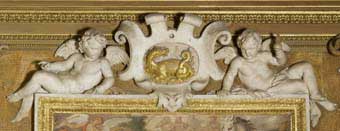
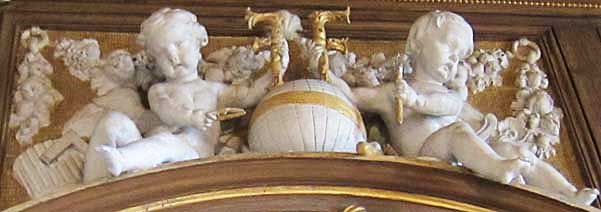
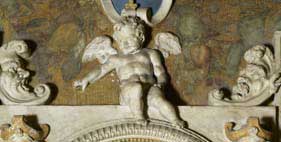
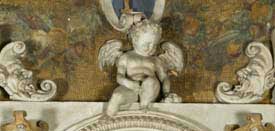
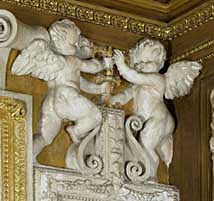
This last pair is among our favorites. Perhaps their pose is closest to those on our chairs in the sense that the putti pivot inward and engage with each other while grasping at a portion of a garland.
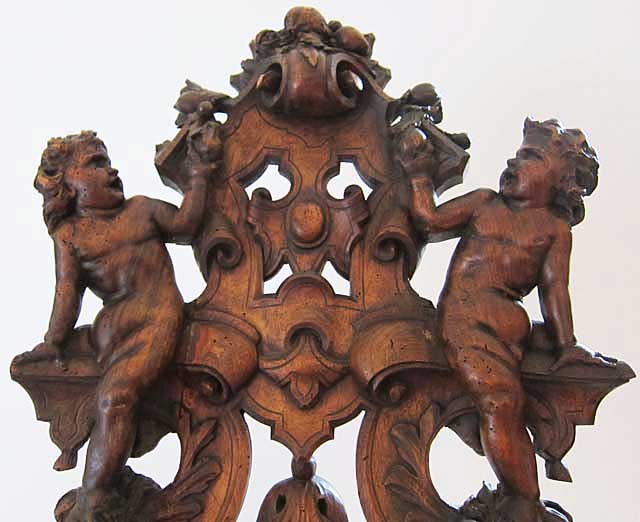
The putti on our chairs suggest these classic designs. Their hair is tousled. They are chubby, with neck, torso, and thighs marked by folds of skin. Their grasp on the side of the chair is firm with hands intricately carved.
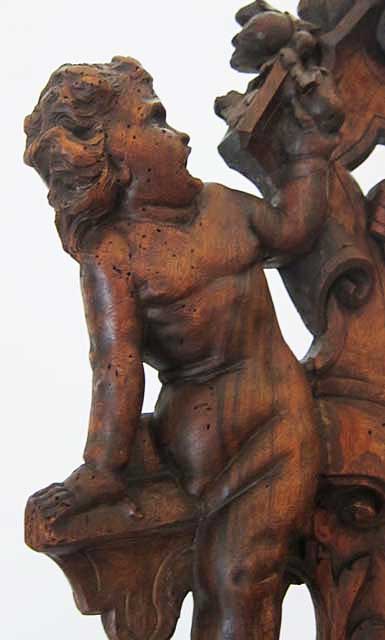
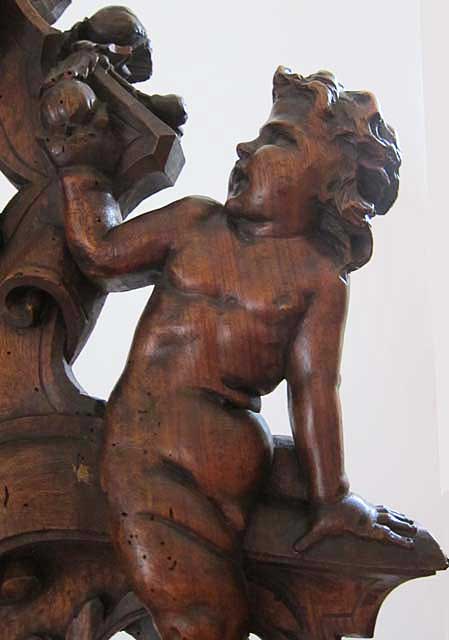
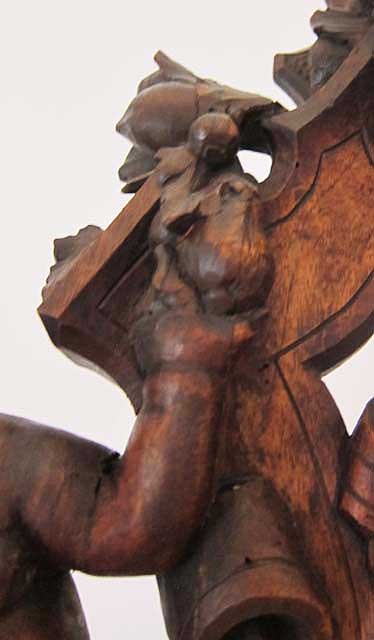
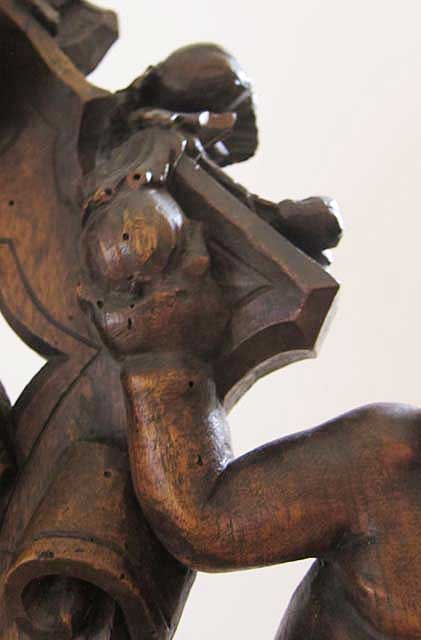
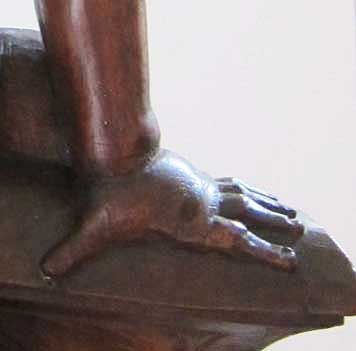
Their feet are planted firmly on what looks like a rock but proves to be the small head of a lion. The creature's muffle is exquisitely carved and calmly expressive for a lion so tame under the foot of a putto.
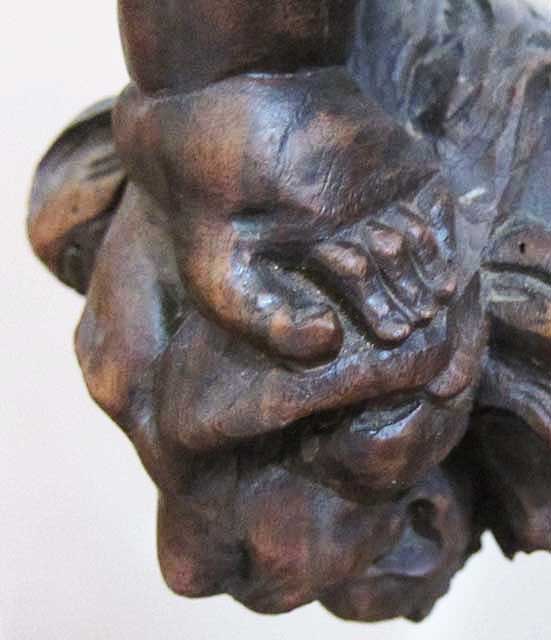
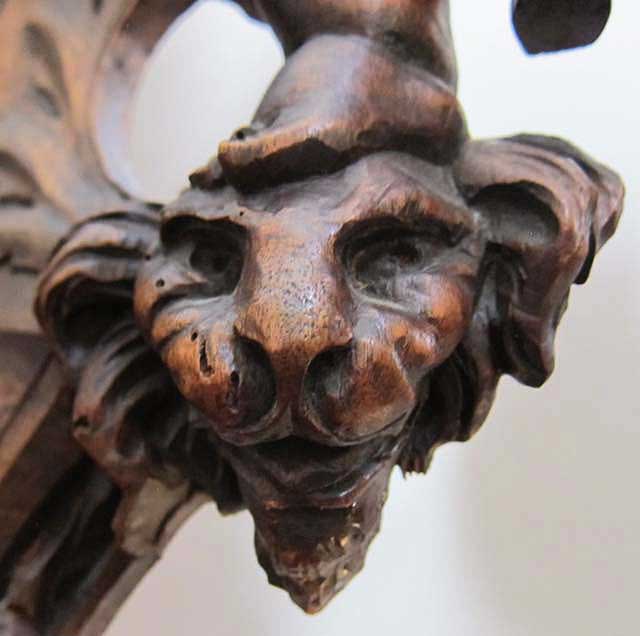
The artist who created these chairs succeeded in conveying through them the sense of play and enjoyment captured so deftly by Rosso in his putti at Fontainebleau.
The other significant figure from the Galerie, and also central to our chairs, is the satyr.

It reminds us of the tall male figure on the left side of the fresco entitled L'Ignorance Chassée or The Expulsion of Ignorance from the Galerie at Fontainebleau. On the right side of the fresco is a female version.
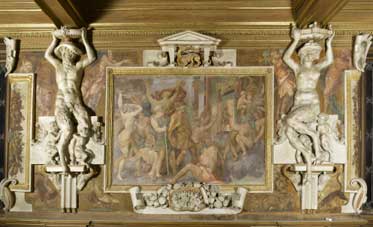
Satyrs or chèvres-pied also have their origins in Greek and Roman mythology. They gave us the term "satire" from their role in the chorus of plays of ancient Greece, where they mocked the other characters. As adapted further by the Romans, the upper part of the satyr's body is a human male and the lower half a goat, including thick hair on its thighs and hooves instead of feet. Horns may appear on their heads along with a beard tapering to a fork, further linking them to a goat's appearance. Satyrs were often the companions of Bacchus, depicted as lovers of wine, women, and song (including playing Pan's flute).
Rosso's satyr leans on a ledge in a twisting pose reminiscent of figures created by Michelangelo for the ceiling of the Sistine Chapel. Extended above his head, the satyr grasps a vase on a pedestal whose shape frames the top of his head. At his feet are two satyr children, possibly offspring shared with the female satyr on the right side of the fresco. Emphasizing his nature as partly goat, he dangles a hoof along the front of the platform on which the satyr children crouch.
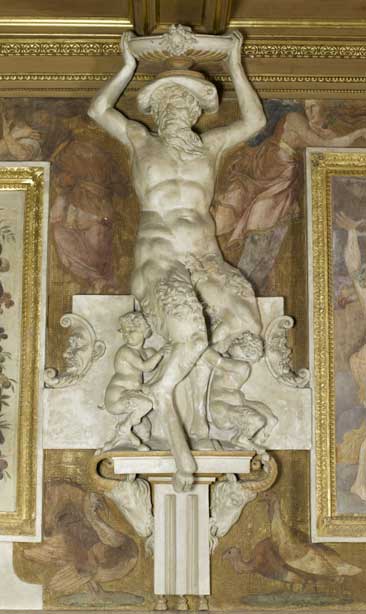
The satyr at the base of our chairs strikes a similar, twisting pose.
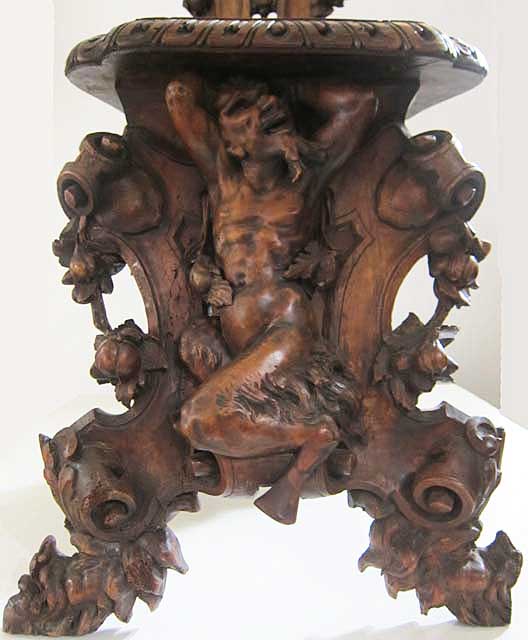
One leg is bent and dangles below the niche in which he is seated.
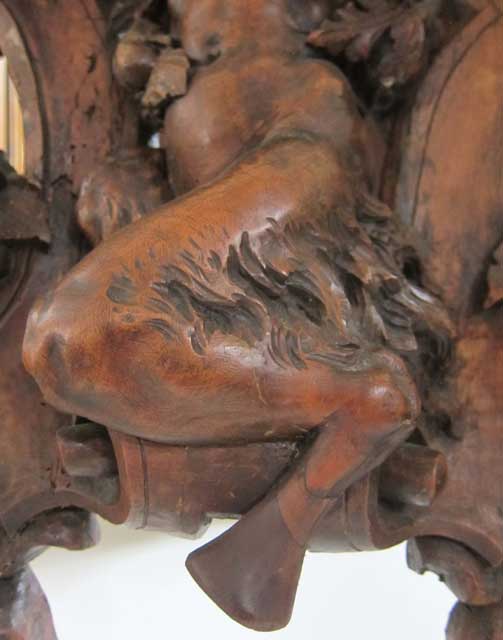
The thigh is suitably hirsute, the carving a triumph of detail and verisimilitude for what is, after all, a mythological creature.
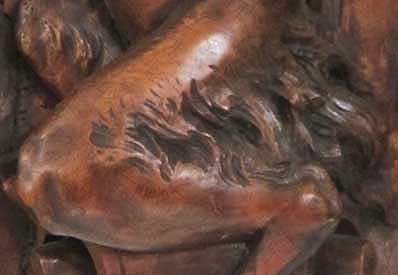
He appears to hold up the base of the seat with his uplifted arms. His torso ripples with exertion of muscles.
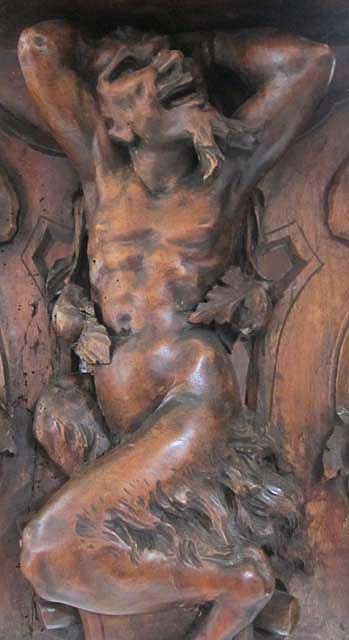
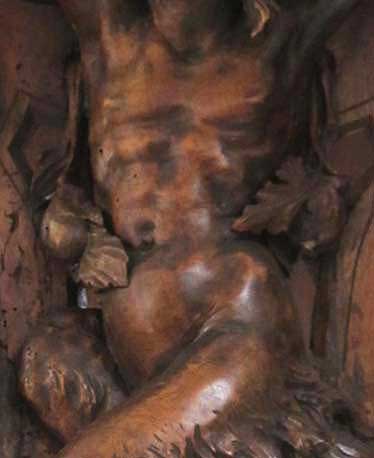
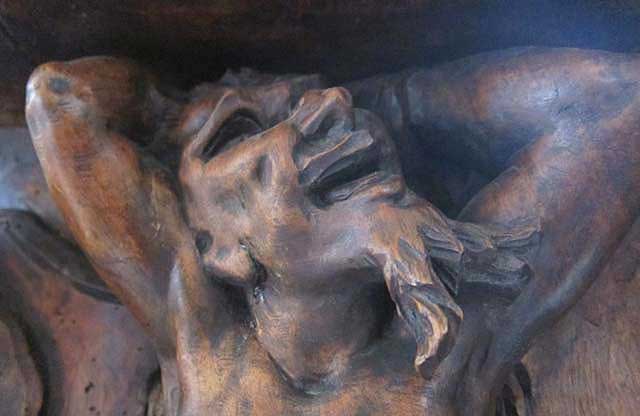
Unlike Rosso's satyr, ours looks upward with a gaze that is expressive, perhaps anxious. His beard is forked, as a goat's, and horns are barely discernible on his head. His mouth is open, perhaps about to utter something about the magnitude of his task. The details of the carving are exquisite, lifelike, designed to draw us into whatever drama the satyr is acting out.
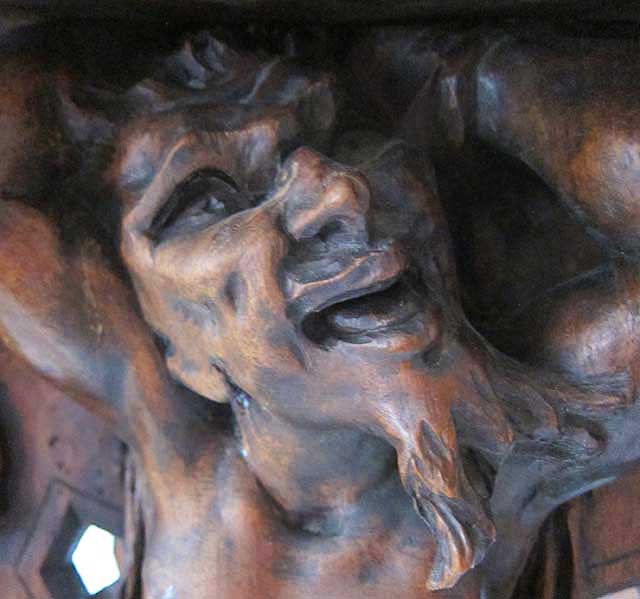
Surrounding the satyr is a frame of strapwork or cuir-découpé. A common motif in Renaissance decorative arts, it was also called ornement auriculaire, referring to strips of leather ending in curls in the shape of ears. It is thought that the motif derives from metalwork scrolls first seen in Islamic art; however it was used commonly for the frontpieces of books published in Paris as early as the late 15th century. By the 16th century, it was common in architecture and furniture.
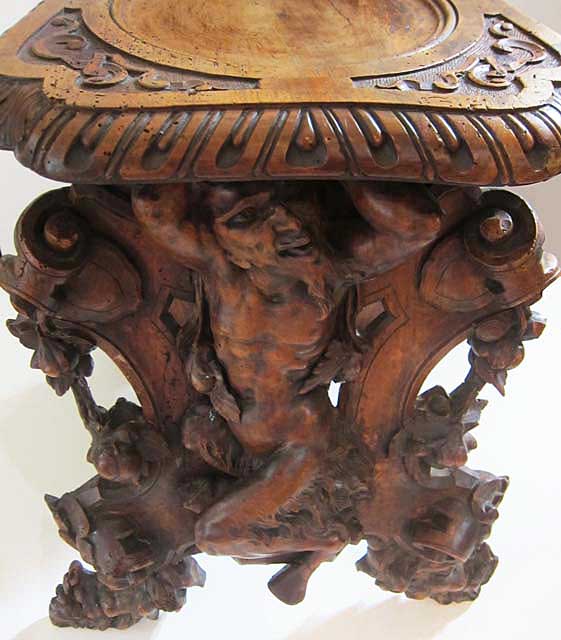
The sides of the base of the chair offer more strapwork ornaments with precisely carved acanthus leaves and fruit.
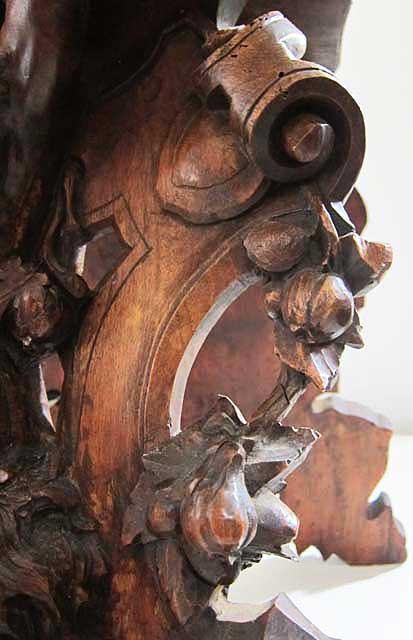
Rosso has been credited with popularizing strapwork as a sort of scrollwork, frequently pierced, that appears throughout the Galerie and was used by subsequent artists, such as Jacques Androuet du Cerceau, in designs for furniture. Most often, it is combined with other elements of 16th century design such as garlands and candelabras considered "grotesque" in the style copied from ancient Roman frescoes found in grottoes discovered during the Renaissance. Examples in the Galerie include the frame of the fresco illustrating a battle with another half human-half animal figure, the centaur.

Strapwork also acts as the framework for the design comprising the upper portion of our chairs, characterized by a gentle curve from side to side. The putti sit on horizontal pieces of strapwork as if balanced on a trapeze.
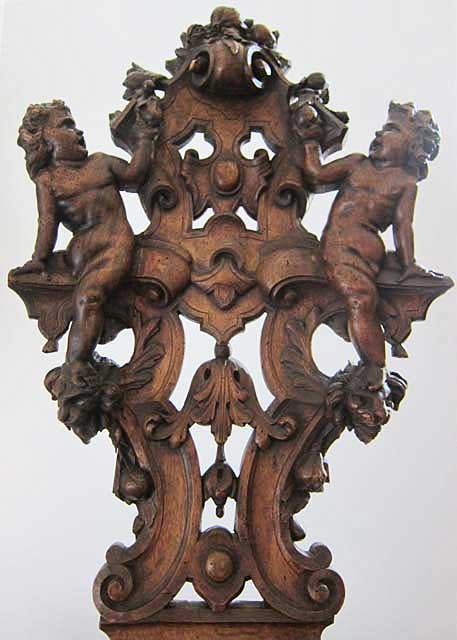
The chair is crowned by a piece of strapwork curled toward the front and topped by elements of the intricately carved fruit and acanthus leaves comprising the garland that makes its way into the outstretched hands of the putti.
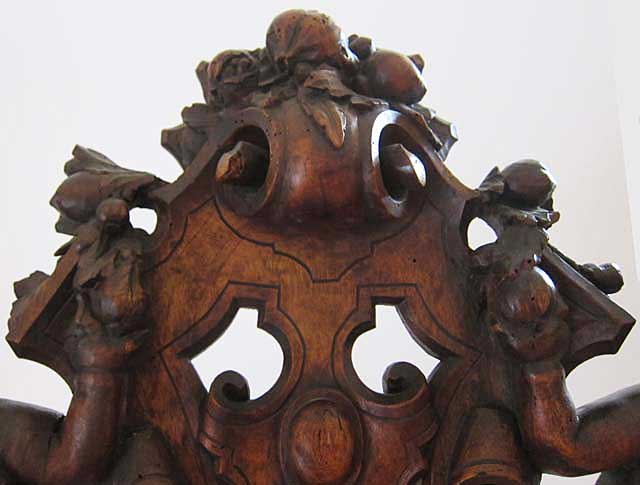
At the center is a floral design resembling an upside down, open tulip or an arrangement of acanthus leaves. Above and below it are convex circles, known as a miroirs, named for small, precious convex mirrors that were popular at the time. The base of the back ends in curled figures or volutes.
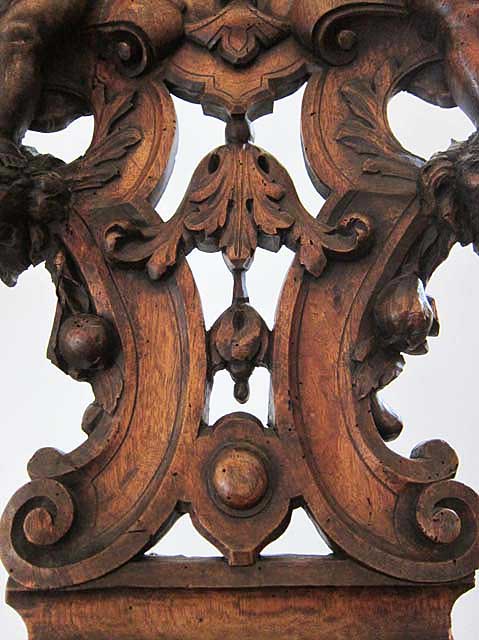
Supporting the front of the bottom part of the chairs are feet that terminate in what look like heads of dogs.
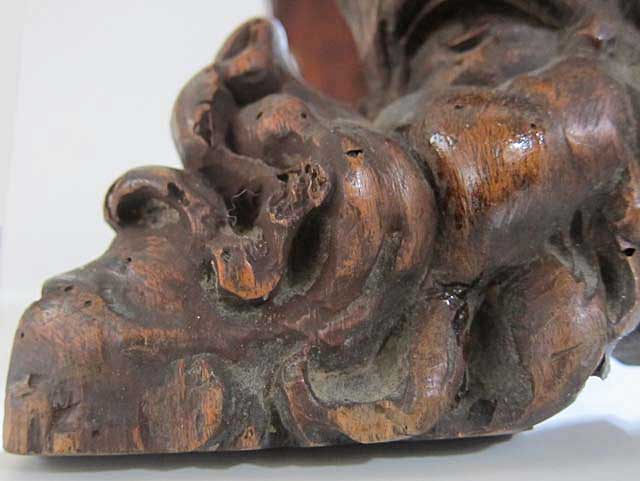
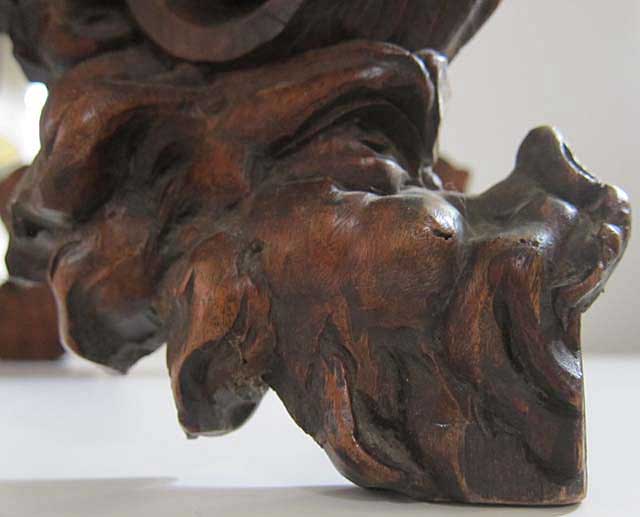
The seats of these sgabelli are typical. Trapezoidal in shape, the seat is wider at the front. A carved border follows the perimeter whose shape indents at the corners. In the center is a circular form, approximately the size of a dinner plate, whose center is lower than its circumference. Each of the four corners has a decorative motif on a stippled background. It involves curled ribbons echoing the strapwork elements used as the framework for top and base.
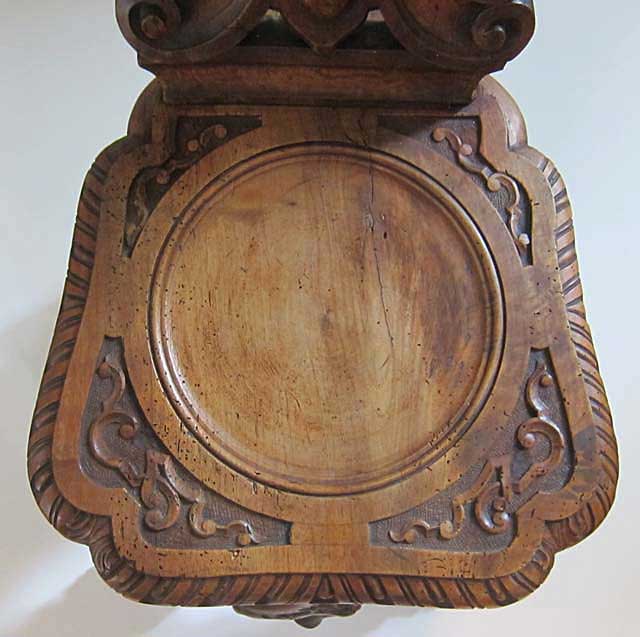
Looking at these chairs from behind, it is fascinating to see the outlines of the designs elaborated on the front.
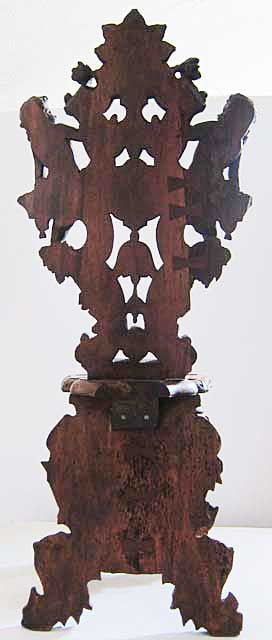
For other pieces including elements from Rosso's designs, see mirror 9227, table 5219, chest 5154, wooden box 9460, and bench 5220.
It is bench 5220, in particular, that has the most similarities to our sgabelli in terms of stylistic elements used by Rosso in the Galerie.
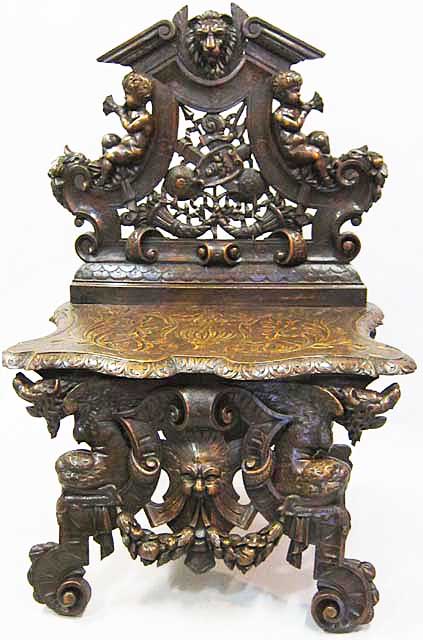
It is evident that our chairs have suffered some damage over the centuries including bits that have rotted, holes from insect damage, and small pieces that are missing. This leads us to suspect that they may be older than 1890, the date stated when we acquired them. We have not tried to make them perfect as when they were new. Instead, we opted for structural integrity in the form of extensive repairs to the back of one of the chairs in order to reinforce the putto and to stabilize the base. This was undertaken by our master woodworker, George Greider, involving the sophisticated technique used for museum-quality furniture known as a butterfly joint (also a bow tie or dovetail key), as evident in the following photos.
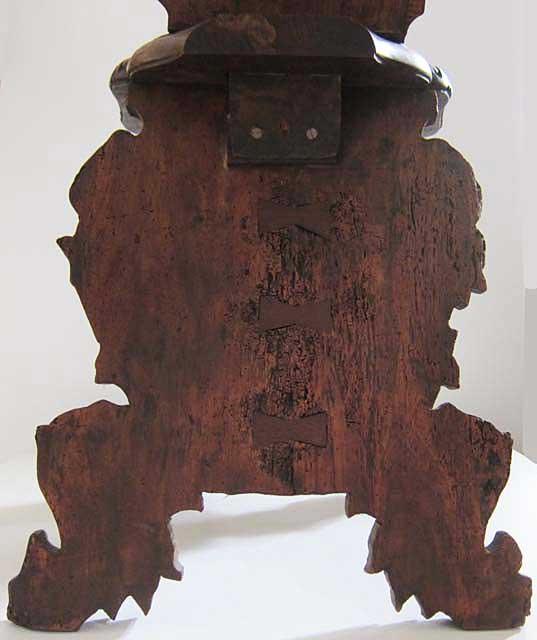
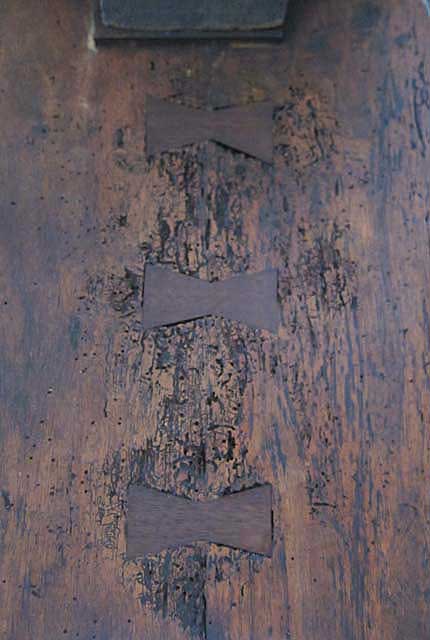
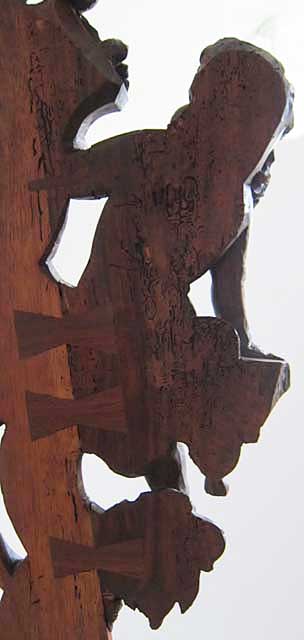
Sometimes we are asked, "Why are sgabello-style chairs so expensive?" The answer is that they are more akin to sculpture than to seating. Of museum quality, this pair is unlike anything we have seen before. And while the name is Italian (escabeau in French), they are certainly French in a style that found great favor during the Renaissance and the revival of its designs in the 19th century.
When acquiring sgabelli, we have learned to be cautious and to select only examples that are solid and sturdy. Too often, they are falling apart or already in pieces! A primary indicator of excellence and longevity is the thickness of the wood, both for the back and for the base that supports the seat. In other words, a chair should be heavy, even after much of the wood has been carved away in crafting the work of art that a sgabello becomes. If not, it was probably made more recently and for a purely decorative purpose. The sgabelli in our collection are intended to be admired as works of art. While it is possible to sit in them, doing so would obscure their beauty! Gazing at these chairs, we are transported back to the time when they were conceived as a triumph of the carver's art in tribute to Rosso Fiorentino and the Galerie François I.
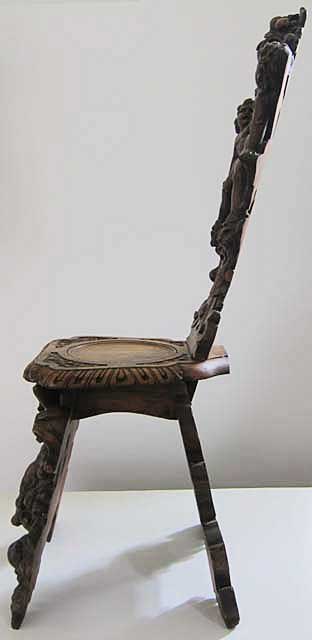
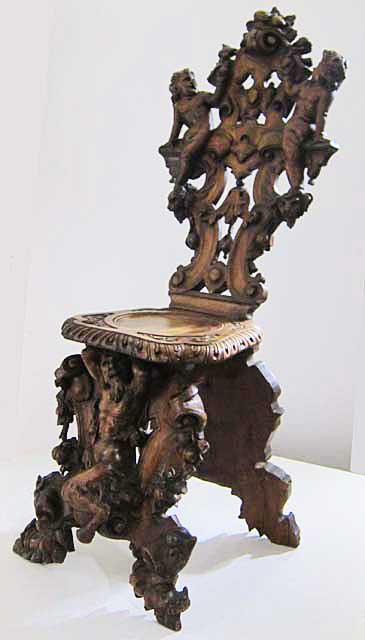

Reference
Bos, Agnès, Mobilier du Moyen Age et de la Renaissance — La Collection du Musée du Louvre (Editions du Musée du Louvre/Somogy, Paris, 2019); Carroll, Eugene A., Rosso Fiorentino, Drawings, Prints, and Decorative Arts (National Gallery of Art, Washington, D.C., 1987); Carroll, Eugene A., Rosso Fiorentino — Paintings, Drawings, Prints, and Architecture, (On line from Vassar College, Poughkeepsie, 2016); Crépin-Leblond, Thierry, Le Roi et L'Artiste (Réunion des Musées Nationaux, Paris, 2013); Salmon, Xavier, Fontainebleau — Le Temps des Italiens (Editions Snoek, Gand-Courtrai, 2013); Thirion, Jacques, Le Mobilier du Moyen Age et de la Renaissance en France (Editions Faton, Dijon, 1998); Ward-Jackson, Peter, Some Main Streams and Tributaries in European Ornament from 1500 to 1750 (Victoria and Albert Museum, London, 1969); Wardropper, Ian, The Flowering of the French Renaissance (Metropolitan Museum of Art, New York, 2004)
Uses
Ideally, these chairs would sit in an entryway on either side of a walnut table or chest. For example, Table 5182 has the head of a putto or angelot at each corner to harmonize with the putti on the chairs. Chest 5154 would also be attractive between these two chairs, considering that its exquisitely carved elements, such as the salamander, are also linked directly to Fontainebleau. To reflect it all in a triumph of Fontainebleau Style, our Mirror 9227 with strapwork, garlands, and an enigmatic coat of arms, would be ideal. The best soundtrack to accompany enjoyment of these chairs could be Rigoletto by Giuseppe Verdi, an opera based on the novel about King François I enjoying himself, Le Roi S'Amuse, by the collector of Gothic style furniture and novelist, Victor Hugo.
